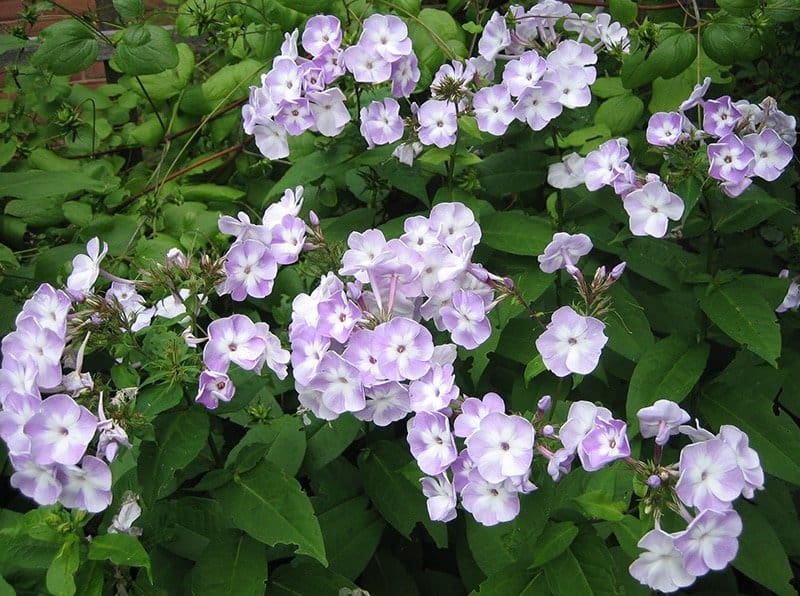
I’ve had an early onset of mildew on summer phlox (Phlox paniculata) this year. These scented, long-blooming perennials are one of the backbones of summer gardens, providing a broad range of colours from midsummer through to first fall frost. Mildew pathogens infect the stems, flowers and foliage, growing quickly to make phlox clumps seriously unsightly. When phlox is severely infected with mildew, it’s also likely to show up on asters, bee balm, lilacs and roses.
Mildew first appears as a powdery coating on foliage. The spores are wind-borne and reproduce rapidly in humid conditions, particularly when combined with warm night temperatures. If weather conditions remain warm and humid for long periods, the white powder can gather into solid splotches, eventually covering leaves in thick, white fuzzy patches. Foliage will begin to drop off at the bottom, working upward. Although mildew won’t kill the plant outright, it seriously weakens it, and repeated seasons of attack will eventually cause the plant to die.
Thinning up to a third of the stems increases air circulation and reduces humidity, making conditions less encouraging for mildew to grow. Planting phlox in full sun and avoiding overhead irrigation also keeps foliage dry in normal seasons (as long as there isn’t frequent rain and elevated humidity). Spraying plants before infection is noticed with an organic anti-fungal mixture (such as one tablespoon/15 mL of baking soda and one teaspoon/ 5 mL of insecticidal soap or horticultural oil mixed into a gallon/1 L of water) can also help to prevent mildew from getting started.
But the most effective way to avoid mildew disease is to plant resistant phlox cultivars. Mildew infections can be quite dramatic when they have a strong hold on phlox plants, and that nasty experience has motivated breeders to work on building resistance in the plants. The good news is that there are many lovely phlox cultivars with inbred ability to resist mildew spores. The more cautious news is that geographical climate conditions have quite an effect on determining the strength of inbred resistance. Phlox paniculata ‘Delta Snow’ and ‘Robert Poore’ have been tested in university trials and show strong mildew resistance in Arkansas and North Carolina, but would they be resistant in southern Ontario climate conditions? Those southern and western locations are quite different from our northern region, and there’s less certainty of mildew resistance. And what about ‘Orange Perfection’, ‘David’ and ‘Prime Minister’, three cultivars that show disease resistance in Vermont and New York? Those northeastern states are closer to our own region, and seem a safer bet for Ontario gardens.
I’ve had problems with mildew on phlox in my garden and came to the conclusion that they had to be removed. I replaced them with ‘Katherine’ (lavender with white eye), ‘Orange Perfection’ (coral orange) and ‘David’ (pure white), three mildew-resistant cultivars that have never been infected in my garden. Locating mildew-resistant cultivars for our region may be a bit frustrating, but there is some help. The Chicago Botanic Garden is located in a Great Lakes region, with an Illinois climate somewhat similar to my own in Ontario. Extensive phlox trials were conducted in the botanic garden over a nine-year period, resulting in a list of resistant cultivars to look for at nurseries and in plant catalogues (see https://www.chicagobotanic.org/downloads/planteval_notes/no35_phloxpaniculata.pdf ). The plants might have other growing problems (such as poor cold hardiness or weak stems), but scored high for resistance to mildew. The cultivars from that study showing excellent disease resistance are: ‘Becky Towe’, ‘Bartwelve’, ‘Candy Floss’, ‘Flower Power’, ‘Frosted Elegance’, ‘Goldmine’, ‘Lichtspel’, ‘Natural Feelings’, ‘Peppermint Twist’, ‘Pleasant Feelings’, ‘Rainbow’, ‘Rubymine’, ‘Sherbet Cocktail’, ‘Shortwood’, ‘Swirly Burly’ and ‘Wendy House’. These are some cultivar names to watch for, and perhaps they will put an end to mildew on our lovely phlox plants.








